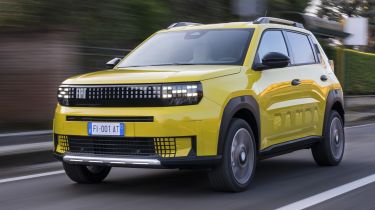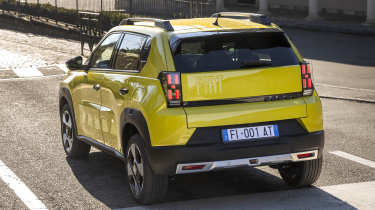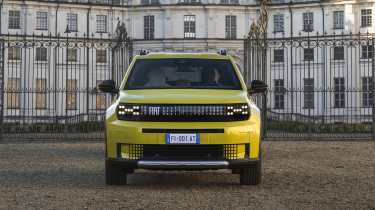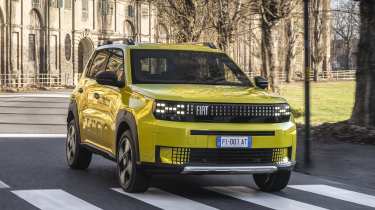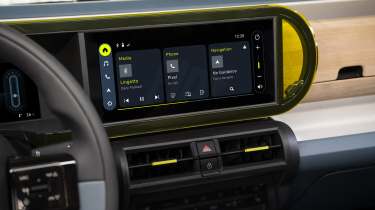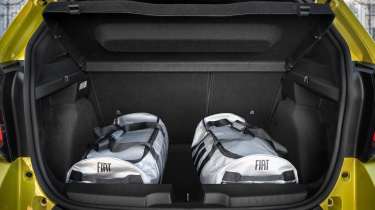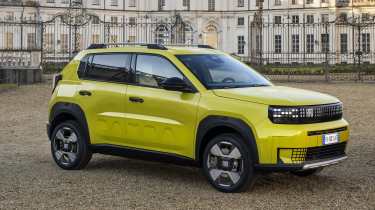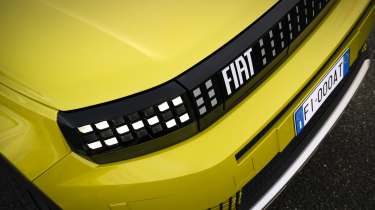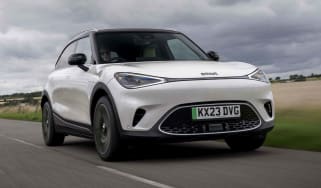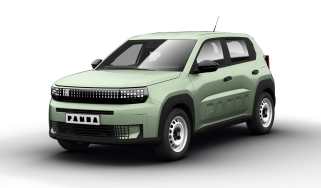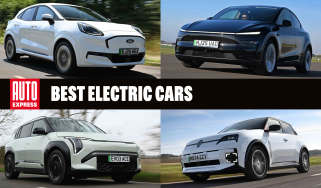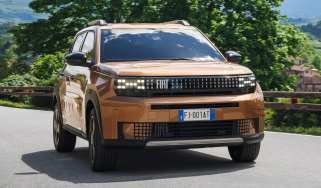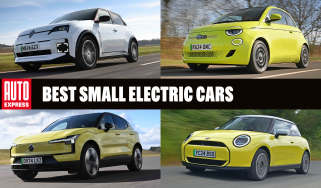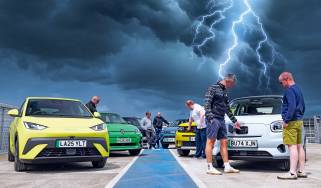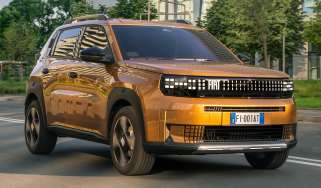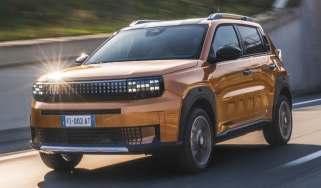Fiat Grande Panda review
Fiat’s alternative to the Renault 5 has the substance to match its style

Our opinion on the Fiat Grande Panda
Building a desirable, affordable car is tough in this day and age, but Fiat has played a blinder by delivering a new Grande Panda that’s not just cheap, but packed full of character and, should you wish, comes with an electric powertrain. There are some issues – motorway refinement could be improved and the rear seats are tight – but there’s so much to love about the new Grande Panda that these are not major concerns, and it’s worthy of our 2025 Supermini of the Year award. Bravo Fiat!
About the Fiat Grande Panda
Icon is a word so frequently used in the car industry that it could well be stripped of all meaning, but it’s entirely justified in the case of the enduring Fiat Panda. Given some of the classic models of the past, interest is always huge whenever a new generation arrives. Fiat has gone big with the new Grande Panda, not just in terms of size – this is now firmly a B-segment offering – but also with its compelling styling, electric range and aggressive price point.
We’ve tested the Fiat Grande Panda in both fully electric and hybrid forms, and both models offer plenty of value for money. While the Renault 5 took a lot of attention away from the older Fiat 500e for those looking for a modern car with plenty of retro charm, the Grande Panda’s distinctive styling, sensible kit and affordable price should be enough to sway at least some buyers back towards the Italian brand. It’s also worth noting that hybrid power is an option that the R5 simply doesn’t have.
Fiat Grande Panda prices and latest deals
Fitted with an electric powertrain, the Grande Panda costs from just over £21,000 for the entry-level RED model and just under £24,000 for the fully loaded La Prima. This makes the Grande Panda one of the cheapest electric cars on sale. If you prefer your cars with an engine, the hybrid is available for even less, around £2,000 model for model.
You can also build the perfect Fiat Grand Panda via the Auto Express Buy a Car service, where you’ll save an average of around £2,400. We can also help you sell your car.
Performance & driving experience
Pros |
|
Cons |
|
For now the electric Panda comes with a single battery electric powertrain option that pairs a 113bhp e-motor mounted on the front axle with a 44kWh battery pack. This offers a good balance of performance and range considering, the price point.
The hybrid, meanwhile, is powered by a 1.2-litre petrol engine paired with an electric motor to produce a similar grand total of 110bhp.
The handling, meanwhile, is tidy and controlled, but doesn’t go out of its way to entertain. The playful edge that used to be associated with Italian superminis isn’t quite there, but then few, if any, of the Grande Panda’s rivals drive in this manner.
More important will be the fact that the Grande Panda rides remarkably well considering its short wheelbase. Even over the cruddy roads of central Turin that we experienced, the Panda never crashed into potholes or speed humps, feeling polished and even quite plush on occasion.
| Model | Power | 0-62mph | Top speed |
| Grande Panda 1.2 Hybrid Pop | 110bhp | 11.2 seconds | 99mph |
|
Grande Panda 1.2 Hybrid La Prima
| 110bhp | 11.2 seconds | 99mph |
|
Grande Panda 83kW Red
| 113bhp | 11.5 seconds | 82mph |
Performance, 0-60mph acceleration and top speed
Taking 11.5 seconds to go from 0-62mph, the electric Grande Panda is no firecracker to drive, something only accentuated by the rather leisurely response from the e-motor. Hit the accelerator with a firm prod and the car will make progress, but at its own pace.
It’s a very similar story with the hybrid, which will cover the 0-62mph sprint in a similarly leisurely 11.2 seconds. This model can get up to 20mph without awakening the petrol engine, but once it does kick in, it remains pretty quiet unless it’s pushed very hard. Gear shifts from the six-speed, dual-clutch automatic are smooth, too.
Town driving, visibility and parking
Take a trip to Italy and you’ll undoubtedly see scores of Pandas both old and new earning their keep as runarounds and undertaking just about every task imaginable. It’s the city streets where every generation of Panda has thrived, and the Grande Panda is no exception.
Both the electric and hybrid variants are easy to drive in town, thanks to good all-round visibility and controls that are easy to modulate. However, poorer road surfaces do upset the ride quality at lower speeds, and the Fiat rides a bit firmer than the closely related Citroen C3.
Country road driving and handling
Unlike the Renault 5, which provides at least a slight entertainment factor, the Fiat Grande doesn’t really offer any thrills. It does manage to hold its own on twistier roads, though, and body lean is kept well in check despite the car’s rather tall stature. The steering feels well-weighted and is pleasant to use, too.
Motorway driving and long-distance comfort
When cruising at motorway speeds, both versions of the Grande Panda provide just enough grunt to keep up with traffic. However, ambitious overtakes will need to be made with a degree of caution and some forward planning.
Should the unforeseen happen, the brake pedal provides a reassuring level of feedback, as do the brakes themselves.
“The steering is largely well judged. Goldilocks would approve of the weighting (not too heavy, not too light) and the gearing’s equally appropriate, turning in responsively enough without any unwelcome dartiness.” - Phil McNamara, editor-at-large.
Range, efficiency & running costs
Pros |
|
Cons |
|
While the electric variant will always have an edge when it comes to running costs, the hybrid-powered Grande Panda is far from being a financial mistake. Officially, this car can surpass the 55mpg mark, and we managed a respectable average of 46mpg after a mixture of roads and speeds.
| Model | MPG | CO2 | Insurance group |
| Grande Panda 1.2 Hybrid Pop | 56.5mpg | 115g/km | 19 |
| Grande Panda 1.2 Hybrid La Prima | 55.4mpg | 117g/km | 20 |
| Grande Panda 1.2 Hybrid Icon | 55.4mpg | 117g/km | 20 |
Electric range, battery life and charge time
A 199 mile range was one of the big headlines when Fiat’s Grande Panda EV was first announced, and it certainly delivers good efficiency at low speeds and in town, where it’ll mostly be driven. However, on faster roads, the bluff front end seems to blunt the aero, causing that figure to drop.
When we conducted a test of driving EVs until they died, the Fiat returned an average efficiency of 3.1 miles per kWh. This equated to a total range of 134 miles, some way short of the 199 miles Fiat claims on paper. In comparison, the Renault 5 returned 3.9 miles per kWh and 143 total miles (193 was the test car’s official range).
Charging the EV from a home wallbox rather than relying on public infrastructure will help to keep this particular cost at bay. You’ll be able to fully recharge the 44kWh battery in around seven hours. If you’d prefer to rapid-charge it, this will take around 30 minutes to top up from 20 to 80 per cent at a rate of 100kW.
| Model | Battery size | Range | Insurance group |
| Grande Panda 83kW La Prima | 44kWh | 199 miles | 24 |
| Grande Panda 83kW Red | 44kWh | 199 miles | 23 |
Insurance groups
While it’s a budget-oriented car first and foremost, neither the electric nor hybrid Fiat Grande Panda offers mega savings on insurance premiums. The hybrids sit in groups 19 and 20 (the lowest being the Pop trim), while the EV is pricier in groups 23 and 24 (here, Red trim is the cheapest).
Tax
It’ll probably come as no shock that the electric car offers the biggest tax savings for company car drivers. Zero emissions mean the Grande Panda EV sits in the three per cent Benefit-in-Kind bracket. The hybrid version sits in the 29 per cent tax bracket, which is sadly higher than the more parsimonious Toyota Yaris starting in the 24 per cent tax bracket.
Private buyers will have to pay the standard annual rate of vehicle excise duty (VED) similar to the hybrid version, because EVs no longer qualify for a discount.
Depreciation
Our expert data shows that after a period of 36,000 miles or three years, the Fiat Grande Panda EV should retain around 42 to 46 per cent of its original value. The hybrid fares similarly, maintaining 42 to 43 per cent.
The Renault 5, meanwhile, holds on to 49 to 51 per cent over the same period, while the Fiat’s sibling, the Citroen e-C3, only manages 42 to 44 per cent.
To get an accurate valuation for a specific model, check out our valuation tool...
Interior, design & technology
Pros |
|
Cons |
|
What is it about small Italian cars and the importance of design? Vauxhall doesn’t have any pressure to wow people with a Corsa, nor Toyota with its Yaris. But when a new Panda is on the horizon, the anticipation in Italy is tangible, with people praying that a national icon hasn’t been desecrated. Thankfully for Fiat, the Grande Panda carries a design that’s already been widely acclaimed.
Interior and dashboard design
The excellence continues inside, too. This is not a cabin full of expensive soft-touch materials, but the materials that have been used are both distinctive and cleverly applied. The overall oval shape of the dash and many of its parts are inspired by the Lingotto test track that sits on the roof of Fiat’s historical factory in Turin. A fun easter egg is the tiny Grande Panda mounted on the dash next to the touchscreen.
Once again, this fundamentally stylish architecture is dotted with lots of little details that make the Grande Panda feel more like an installation at the Milan Design Fair than an affordable supermini. Few, if any, manufacturers have used coloured acrylic as seen on the dash and, where needed, fabrics have been deployed to keep the overall ambience from feeling too cold or stark.
For the sake of comparison, a new Renault 5 is more premium and has more content inside. But the top-spec Grande Panda is priced at around the level where the R5 kicks off, fitting customer expectations almost perfectly.
Materials and build quality
There are a number of cheaper materials used in order to keep the Grande Panda’s cost under control, but Fiat’s engineers have done an admirable job at hiding these in plain sight. Previous Pandas have held a reputation for being rather durable, and we’re willing to bet that the latest model will live up to this, too.
Infotainment, sat-nav and stereo
Fiat is under no illusion that offering up a twin-screen infotainment system is going to change the world, but it’s a layout that is universally recognised as being effective for a car in this area of the market. The main 10.25-inch touchscreen is mounted in the right position and is clear and fairly easy to use.
There’s some lag to the interfaces, and the actual menu structure could be a little easier to navigate, but as Fiat has kept the air-conditioning controls separate, you can easily keep the interface in a phone-mirroring mode for the vast majority of the time. The driver’s display isn’t hugely configurable, but it still offers all the info you need at a glance.
“Playfulness peppers the delightful cabin, hidden behind that tough but cute exterior. There’s no mistaking it for a dour Volkswagen.” - Phil McNamara, editor-at-large.
Boot space & practicality
Pros |
|
Cons |
|
Even though it’s named ‘Grande’, the latest Panda is still a small car in the grand scheme of things. Some clever design means it’s pretty spacious inside, though, and having the 4.5-metre coil-type charge cable built into the car’s grille negates the need to take up precious boot space or wrestle with stowing it into a bag.
Dimensions and size
The Fiat Grande Panda measures in at 3,999m long, 2,107mm wide and 1,576mm tall. This means it’s both longer and wider than both the Citroen C3 and Renault 5.
| Dimensions comparison | |||
| Model | Fiat Grande Panda | Renault 5 | Citroen C3 |
| Length | 3,999mm | 3,922mm | 4,015mm |
| Width | 2,017mm | 1,774mm | 1,813mm |
| Height | 1,576mm | 1,498mm | 1,577mm |
| Wheelbase | 2,540mm | 2,540mm | 2,540mm |
| Boot space |
412 to 1,366 litres (EV) 361 to 1,475 litres (hybrid) | 326 to 1,106 litres | 310 to 1,188 litres |
Seats & passenger space
Despite its quasi-SUV body, space in the rear of the Fiat is tight. The high floor and slight hump in the rear floor can make it a squeeze for tall rear passengers, but headroom is well catered for thanks to the boxy silhouette. Compared with a MINI or Renault 5, it’s fine, but those hoping for space akin to the Citroen e-C3 or even the Vauxhall Frontera will notice the difference.
Beyond this, though, the Grande Panda scores well. There’s plenty of space up front, and you’ll find a number of storage cubbies inside the dash, between the seats and in the door pockets.
Boot space
The Grande Panda hybrid’s 412 litre boot is one of the biggest in the supermini class, and it’s almost 100 litres more than you’ll find in the Citroen C3. However, the electric variant’s battery has to go somewhere, so the boot in this car shrinks to 361 litres. This is still 35 litres more than a Renault 5, though.
Reliability & safety
Pros |
|
Cons |
|
The Fiat Grande Panda hasn’t received a crash safety rating from the experts at Euro NCAP yet, and neither have its sister cars – the Vauxhall Frontera, Citroen C3 and Citroen C3 Aircross – which are all based on the Smart Car platform from parent company Stellantis. Hopefully we’ll find out how the funky little Fiat and its sibling perform soon.
The Grande Panda’s selection of driver assistance systems will certainly help when it’s put through Euro NCAP’s battery of tests. Every model is equipped with rear parking sensors, cruise control, lane-keeping assist, active safety braking, speed-sign recognition and driver attention monitoring. Top-spec La Prima cars also get front parking sensors and a rear-view camera.
Fiat didn’t fare well in our most recent Driver Power owner satisfaction survey, unfortunately. Owners who responded to our survey weren’t impressed by their car’s powertrains, interiors, ride and handling or practicality, though did praise the low running costs and distinctive styling. Based on their feedback, the Italian brand finished in 21st place out of 31 brands in the best manufacturer rankings.
That being said, other Stellantis marques did much better, with Peugeot securing seventh place. Vauxhall was the best of the bunch, though, finishing in fourth place.
Buying and owning
- Best buy: Fiat Grande Panda 83kW La Prima
The Fiat Grande Panda is a very affordable car both in hybrid and electric forms, so we recommend treating yourself to the range-topping La Prima model in electric form in order to get maximum kit with minimum running costs. If owning an electric car isn’t feasible for you, we’d then suggest opting for the hybrid but in this same trim level.
Fiat Grande Panda alternatives
Fiat’s not the only manufacturer to offer a well-sized, stylish and affordable supermini in both electric and hybrid forms. In fact, two of the Grande Panda’s key rivals are the Citroen C3 and Citroen e-C3, both of which share several of the same underpinnings.
The exclusively electric Renault 5 is a little more expensive, starting just below the top-spec electric La Prima, but you’ll need to keep to the entry-level model. As a car, the Renault is better to drive, more refined, and feels more substantial.
Frequently Asked Questions
Fiat’s standard three-year/60,000-mile warranty applies to both the Fiat Grande Panda hybrid and EV. The latter also gets eight years/100,000 miles of battery cover.
